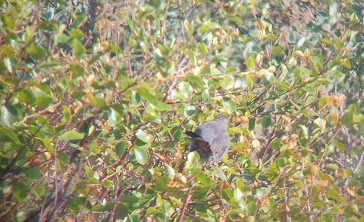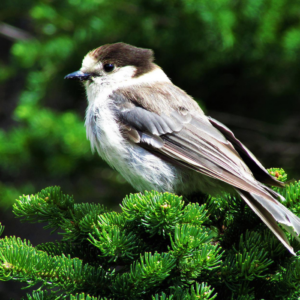Field Notes From Eeyou Istchee
Author: Ted Cheskey
Marc-Antoine and I left southern Quebec on August 13, travelling two days with an overnight stay at the Caribou Motel in Matagami. There, we encountered 20 Common Nighthawks and a leaky tire that we were fortunate to detect and repair the next morning. We arrived at the Waastooskum (“Northern Lights”) Inn on Sunday afternoon.
The next morning, we met with the team at Chisasibi Eeyou Resource and Research Insitute (CERRI) and with our host, Officer John Lameboy of the Eeyou Marine Region Wildlife Board, to discuss our itinerary for the next 10 days. After reviewing maps, John arranged for us to visit the trapline to the north of Chisasibi, accessible by the Long Point Road, and off-road vehicles.
Leaving late the next morning, we split into two teams. One team would be visiting the area to the north of the Long Point road, and the other would head to the south. We travelled by Argo, an impressive military-like all-terrain vehicle that can go pretty much anywhere. Two staff members from CERRI, Preston and Isaiah, joined us for the day.
We were disappointed to find relatively little bird activity—only six species of shorebird—likely due to limited shorebird habitat. But the deep coastal prairie-like wetlands on the north side could have held species of interest such as yellow rail or Nelson’s Sparrow. We concluded that the timing of our visit (both date and time of day) was not optimal for detecting birds, especially breeding birds (very late morning to late afternoon in mid August).
The next day was very calm, and John arranged for the tourist boat to take us into the bay where we could view several islands. Noticing a few flocks of shorebirds, we stopped first on a sand spit a few kilometres off the mouth of the Chisasibi River. There was a noticeable current from the river even there, and the water was not salty. We tallied our largest group of shorebirds for the entire expedition on this island, which amounted to only 80 individuals of five species. A mixture of adult and young Sanderlings and Semipalmated plovers made up the majority of birds.
We continued on our journey to a remote island with a communication tower on it. Over 100 Black Guillemots use this island as a nest site. We did not see any young, but could smell their presence. The high whistled “song” of the Guillemots filled the air, occasionally punctuated by grunts from the Common Eiders that also breed there. This island site was the only one where we observed a large concentration of ducks. Most were too far away to identify, though we did tally 170 Red-breasted Mergansers there. Along the coast of a larger island, we observed our first American Pipit. On our return trip, we stopped at Governor’s Island and took in the view of the beach at the tip of Fort George Island. Despite seeing vast amounts of sand, we did not observe any shorebirds there.

Chisasibi Bird
The following day, we made our way along a network of very rough roads to visit Old Fort George. We hoped to make it to the beach that formed on the western tip of the island, but were unsuccessful, barred by impassable roads and scrubland.
On Friday, there was a community presentation of the project and screening of A Year in the Life of a Red Knot. The video was narrated in Cree by Luci Salt, an elder, educator, Cree translator, and community member of Chisasibi. Luci was unable to attend the event, but her narration brought the video to life! The 30 attendees watched attentively and appreciated the screening.
Officer John Lamboy translated my presentation into Cree with some help from Jimmy Fireman. We talked for nearly two hours, punctuating the presentation with draws for binoculars, donated by the Eeyou Marine Region Wildlife Board and a bird book. Towards the end of the meeting, the participants, all local land users, were invited to mark large maps that CERRI provided with their observations of the species that are relevant to our work. Three hours later, after a great meal and many good conversations, the group dispersed. By all accounts, the event was very successful!
For the next three days, we had hoped to survey large wetland complexes about 35 kilometres to the south, but a combination of weather and logistical issues intervened. Instead we revisited several sites that were accessible by car, including Long Point, the boat launch at the end of the highway, the sewage lagoons, and other areas around Chisasibi. Surprisingly, we found several Mourning Doves that appear to be living in Chisasibi. According to Jimmy Fireman, the doves have been present for approximately five years, perhaps another indicator of climate change?
Tuesday, our last full day in Chisasibi, John arranged for boat captain Ross House and his son Rusty to take us to two Islands that we wanted to visit – Agweekwich Island and one that we named “Tourist” Island as we saw the tourist boat arrive there full of tourists from the south. We left the boat dock before 7:30 am, reaching Agweekwich Island shortly after 8 am. We spent several hours combing the Island, observing American Pipits, Horned Larks, Common Redpolls, a family of Greater Scaup and a few Common Eider families.
There, we found the most unusual species of the trip. We heard it first, almost in disbelief, but there was no doubt. It was a Gray Catbird, captured in the adjacent image, ‘meowing’ about 1000 kilometres north of its range!
At Tourist island, we found seven species of shorebirds, including 34 semipalmated sandpipers and another highlight species—the last one observed before returning to the boat. There were three male Willow Ptarmigans that burst out of a patch of willows, muttering away with their unusual voices. This was our second Ptarmigan observation of the entire expedition (previously observed on an Island in Wemindji where we confirmed breeding), and a very exciting way to end our stay.
In the end, we observed over 4300 individuals of 87 species of birds in nine days of work. We have little doubt that if we had been able to visit the southern bays that we had hoped to, or be there a bit earlier (end of July, beginning of August), this number would be much higher.
Nature Canada is a proud partner with the Cree Nation Government, the Cree Trappers Association and the Eeyou Marine Region Wildlife Board. Information gathered about bird populations during our expedition will support the Cree government and local communities in their work to identify potential protected areas and help with wildlife management decisions.



